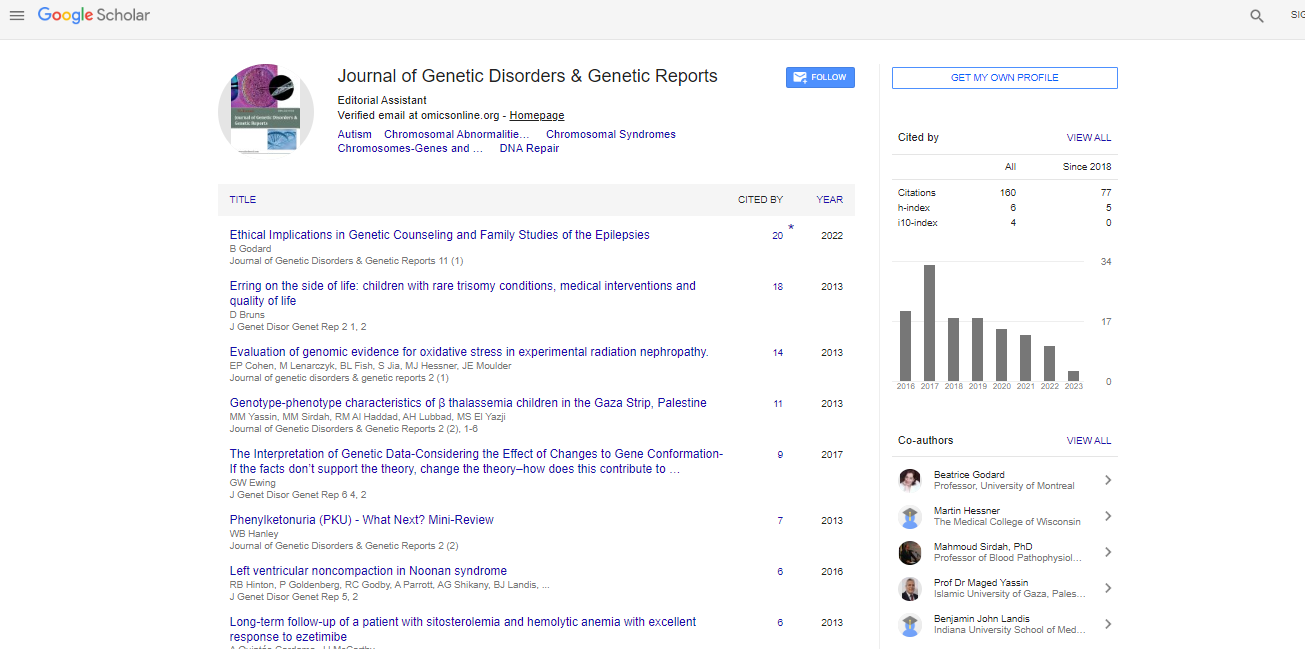Perspective, Vol: 12 Issue: 1
Chromosomal Abnormalities: Causes and Effects on Development
Mustafa Gokhan Ertosun*
Department of Developmental Neurobiology, St. Jude Children’s Research Hospital, 332 North Lauderdale, Memphis, TN 38105, USA
*Corresponding Author: Mustafa Gokhan Ertosun
Department of Developmental Neurobiology, St. Jude Children’s Research
Hospital, 332 North Lauderdale, Memphis, TN 38105, USA
E-mail: MustafaGokhan@adhb.govt.nz
Received date: 25 January, 2023, Manuscript No. JGDGR-23-92049;
Editor assigned date: 27 January, 2023, Pre QC No. JGDGR-23-92049(PQ);
Reviewed date: 13 February, 2023, QC No. JGDGR-23-92049;
Revised date: 20 February, 2023, Manuscript No. JGDGR-23-92049(R);
Published date: 27 February, 2023, DOI: 10. 4172/2576-1439.1000189
Citation: Ertosun GM (2023) Chromosomal Abnormalities: Causes and Effects on Development. J Genet Disor Genet Rep 12:1.
Abstract
Chromosomal abnormalities occur when there is a change in the number or structure of chromosomes in cells. These changes can occur spontaneously or as a result of environmental factors or genetic mutations. Chromosomal abnormalities can have significant effects on development, including physical, cognitive, and behavioural changes.
Description
Chromosomal abnormalities occur when there is a change in the number or structure of chromosomes in cells. These changes can occur spontaneously or as a result of environmental factors or genetic mutations. Chromosomal abnormalities can have significant effects on development, including physical, cognitive, and behavioural changes.
Chromosomal abnormalities can have significant effects on an individual's health and development. These abnormalities can occur during cell division, resulting in changes to the number or structure of chromosomes.
Chromosomal abnormalities refer to changes in the number or structure of chromosomes that can occur during cell division. These abnormalities can lead to genetic disorders or birth defects.
Types of chromosomal abnormalities
Aneuploidy: This occurs when there is an abnormal number of chromosomes. For example, Down syndrome is caused by an extra copy of chromosome.
Deletion: This occurs when a portion of a chromosome is missing. This can result in genetic disorders such as Cri-du-chat syndrome, which is caused by a deletion of a portion of chromosome.
Duplication: This occurs when a portion of a chromosome is duplicated, resulting in extra genetic material. This can cause genetic disorders such as Charcot-Marie-Tooth disease, which is caused by a duplication of a portion of chromosome.
Inversion: This occurs when a portion of a chromosome is reversed in orientation. This can sometimes have no effect, but in other cases, it can cause genetic disorders.
Translocation: This occurs when a portion of one chromosome breaks off and attaches to another chromosome. This can sometimes have no effect, but in other cases, it can cause genetic disorders.
Chromosomal abnormalities can be detected through various tests, including amniocentesis, chorionic villus sampling, and genetic testing. Treatment options for chromosomal abnormalities depend on the specific condition and may include medication, surgery, or supportive care.
One type of chromosomal abnormality is aneuploidy, which occurs when there is an abnormal number of chromosomes. For example, Down syndrome is caused by an extra copy of chromosome, resulting in intellectual disability, developmental delays, and physical abnormalities. Other type of chromosomal abnormality is structural abnormalities, which occur when there are changes to the structure of chromosomes. This can include deletions, duplications, inversions, and translocations. These abnormalities can disrupt the function of genes, leading to a wide range of health problems such as intellectual disability, developmental delays, and physical abnormalities.
Chromosomal abnormalities can also affect reproductive health. For example, certain chromosomal abnormalities can cause infertility, miscarriage, or stillbirth.
Causes chromosomal abnormalities
Nondisjunction: Failure of chromosomes to separate properly during cell division, leading to an abnormal number of chromosomes in cells
Translocations: When a piece of one chromosome breaks off and attaches to another chromosome, resulting in an abnormal chromosome structure
Deletions: When a portion of a chromosome is missing
Duplications: When a portion of a chromosome is duplicated
Inversions: When a portion of a chromosome is reversed
Effects on development of chromosomal abnormalities
Down syndrome: A common chromosomal abnormality where an individual has an extra copy of chromosome, leading to intellectual disability, developmental delays, and physical abnormalities such as a flat facial profile and small stature.
Turner syndrome: A chromosomal abnormality where an individual has only one X chromosome, leading to short stature, infertility, and other physical and cognitive challenges.
Klinefelter syndrome: A chromosomal abnormality where an individual has an extra X chromosome, leading to infertility, developmental delays, and other physical challenges such as enlarged breast tissue.
Cri du chat syndrome: A chromosomal abnormality where a portion of chromosome is missing, leading to intellectual disability, developmental delays, and physical abnormalities such as a highpitched cry.
Overall, chromosomal abnormalities can have a significant impact on development and can lead to a wide range of physical, cognitive, and behavioral challenges. It is important for individuals with chromosomal abnormalities to receive appropriate medical and educational support to help them achieve their full potential.
 Spanish
Spanish  Chinese
Chinese  Russian
Russian  German
German  French
French  Japanese
Japanese  Portuguese
Portuguese  Hindi
Hindi 



